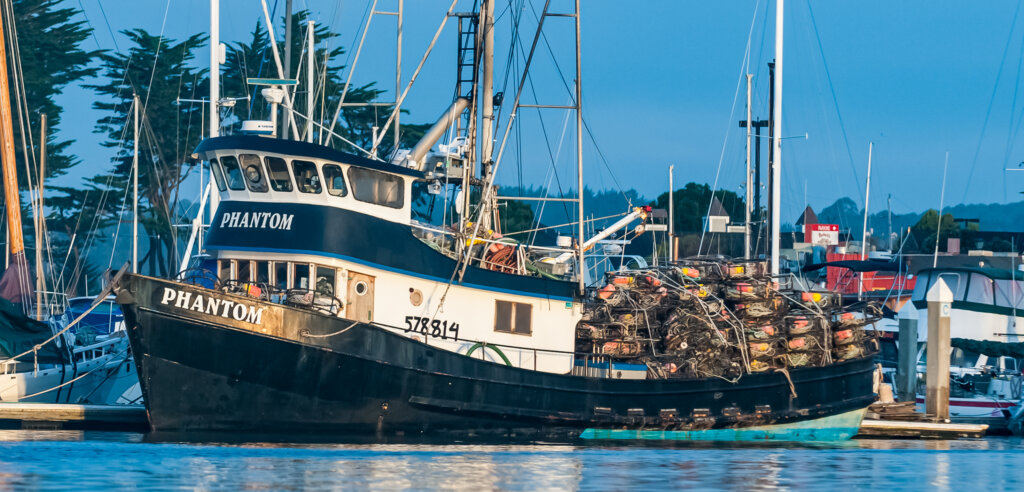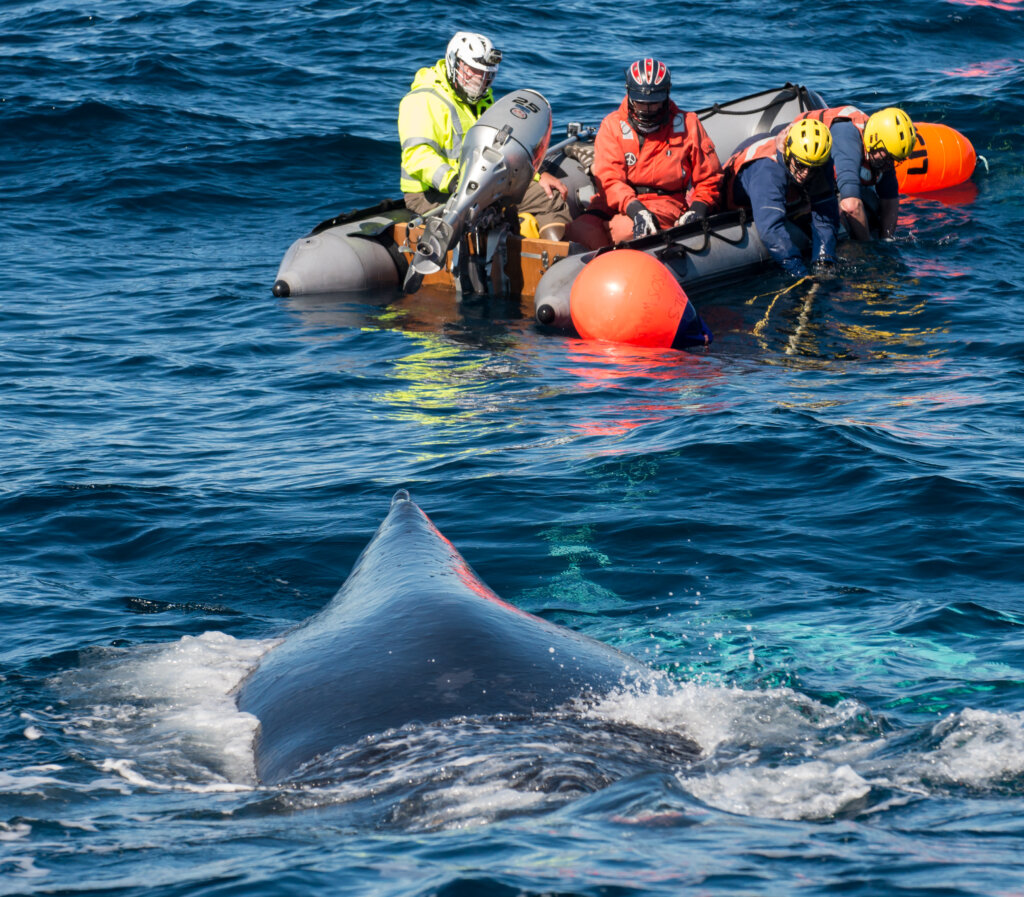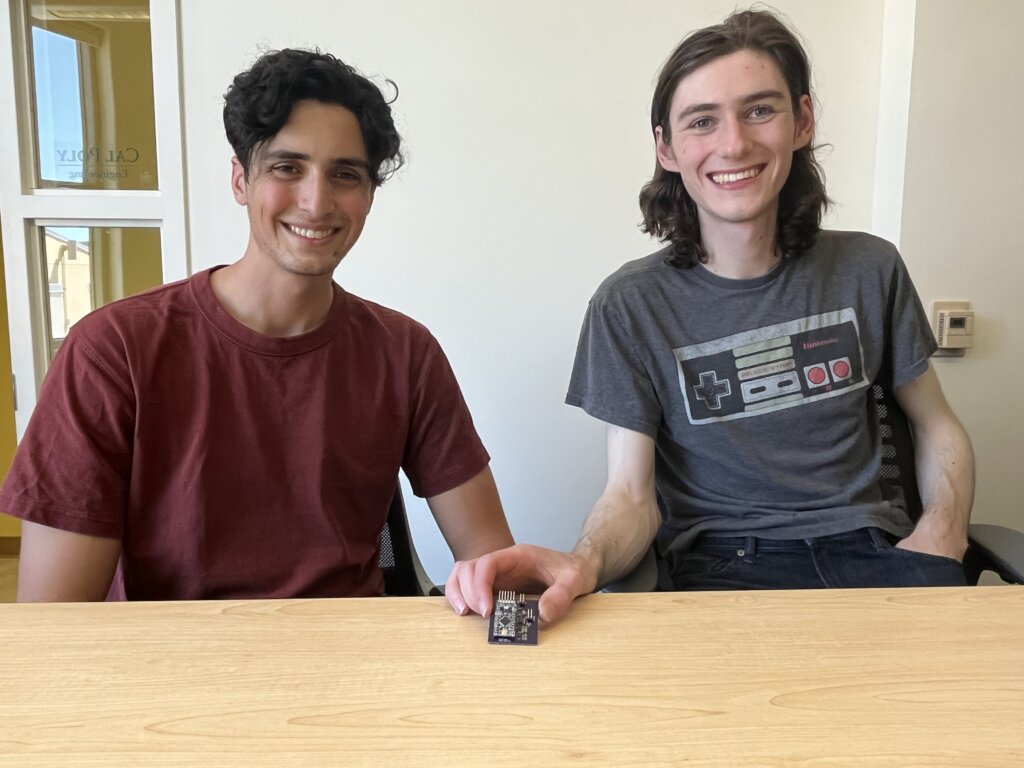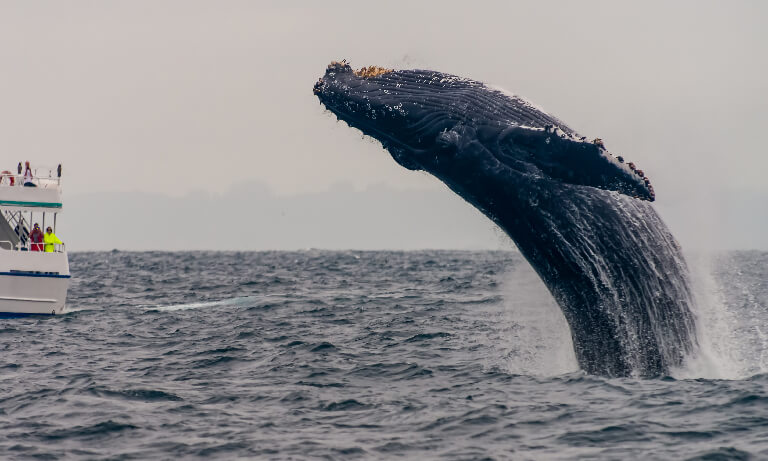Two Cal Poly engineering students, their professor and a Silicon Valley engineer who share a love of the ocean are collaborating on a project to save the whales and sustain the crab fishing industry.
As the whale population has grown, so has the number of reported entanglements with commercial fishing gear, leading to injuries, infection and a sharp increase in deaths. In response, the state has adopted mitigation measures that include shortening the commercial fishing season or closing areas.
Those rules, however, have led to economic distress for the Dungeness crab fishery that is vital to many small, rural communities on the West Coast.
“Whale entanglements have become a huge environmental issue and are affecting a huge industry,” said interim Associate Dean and Computer Engineering Professor Bridget Benson. “A lot of people are trying to find answers to this significant problem.”
The Marine Mammal Protection Act, signed into law in 1973, specifically says that bycatch – killing marine mammals in the course of fishing – must be brought to zero. Despite the substantial efforts of researchers and engineers, the situation has worsened for large whales and fishers.
The answer could lie in a device patented by Silicon Valley engineer Bart Selby that uses electronic sensors to identify entanglements as they happen, then uses pyrotechnics to drive a knife through the line connecting the whale to the trap, freeing it.
Selby enlisted Cal Poly students to build a system that utilizes a microcontroller and sensors to monitor the changes in the crab pot’s movement and depth consistent with a struggling whale.
“This project could help save the whales but also help local fishermen – local community members who rely on fishing for their livelihood,” said Benson, who is advising the two students undertaking the project this year. “And there’s definitely a cool factor to it.”

Inspiration Strikes
Selby, a mechanical engineer who grew up in Ohio, was drawn to the Bay Area by the pull of the sea when he graduated from Ohio State in 1979. He has a wide range of experience in the tech world – life science startups, a couple of patents in DNA sequencing, and aerospace pyrotechnics.
In 2012, he joined a whale disentanglement team that would deploy in small rubber boats to seek out entangled whales they could free.
“It was hard to find the whales, and when we did find them, it was too late,” said Selby, referencing a whale they found off Monterey Bay that had been trapped for over a month and would not survive.
Frustrated by futile rescues, Selby had what he calls his “flux capacitator moment,” likening his brainstorm to the breakthrough in the film series “Back to the Future” that allowed for time travel.
“In that moment, I understood why whales were getting entangled and how I could fix the problem,” he said.

When whales get caught in fishing line, they roll and twist just as they would if they were snarled in kelp, according to Selby, who realized electronics could hold the key.
“It’s like an airbag in a car, always primed and ready,” he said. “We can’t stop all collisions or whale entanglements, but we can make them less lethal.”
A crab pot when retrieved by a fisher is quickly, uniformly hauled from the bottom to the surface. When entangled by a whale, the pot moves up and down and is dragged along the bottom. The device monitors depth and acceleration and if it doesn’t fit the haul-in profile, the pot is cut free.
An added benefit is fishers can use the same gear and methods without impact to productivity, Selby said.
He secured a patent for his autonomic line cutter in 2020 but needed help with the electronics to control the device, so he turned to Cal Poly.

Under the Sea
Selby shared his idea with colleagues in the field, including Chris Hagler (Electrical Engineering, ‘80), retired director of hardware engineering at Amazon, who said the circuit board project would be perfect for electrical engineering students at his alma mater.
Hagler contacted then-Chair Dennis Derickson, and Selby pitched his idea that was adopted by three electrical engineering students – Paul Kibble, Yale Hone and Ben Bradley – for their senior project. Benson was tapped to be their adviser, because of her background with underwater technology.
She considered studying marine biology in college but did not like dissecting animals in biology class, so she opted for computer engineering. Nevertheless, she integrated her interest into her studies, developing an acoustic modem for coral reefs that could collect data without laying cables on the seafloor for a graduate project at UC San Diego.
During her time at UCSD, she also worked as a divemaster for Reef Check, a nonprofit organization that trains certified divers to count and classify algae, fish and invertebrates within the world’s rocky and coral reefs.
Benson worked with the electrical engineering students as they spent their year building a device on a breadboard. While primitive, the prototype gave Selby a proof of concept and motivation to continue his collaboration with Cal Poly.
“The kids are great,” he said. “They are bright, motivated, and I feel like I can teach them something about the product development process.”

Answering the Call
Richard Rios and Dash Peters were in Benson’s computer engineering course on microcontrollers when she asked if anyone was interested in taking the whale project to the next level.
Rios, a fourth-year computer engineering student who has always lived near the ocean, and Peters, a third-year computer science student who sails and scuba dives, signed on. Both are from the Bay Area.
“I was interested because of the environmental impact and goal of saving the whales for a project that would involve both design and programming,” Rios said.
Peters, who was drawn to the hardware aspect, jumped into creating a much smaller circuit board, learning system design and reflow soldering in the process.
“We could convince fishermen to use this device if it’s smaller, less intrusive and easier to adopt,” he explained.
Peters and Rios are launching the first stage of data collection, when they will measure ocean conditions, movement of a crab pot resting on the seafloor and acceleration of a winch.
“We want to have a prototype that we can put in the water to show that the concept will work,” said Rios, adding the pair recently visited the Cal Poly Pier in preparation for testing.
A prototype could convince state officials or foundation members to fund buildout with the end goal of bringing a product to market, according to Selby.
“We want to help Bart take that next step to secure funding,” said Rios, who added he’s gleaned knowledge from Selby about commercialization. Rios will graduate in the spring but remain at Cal Poly to pursue a master’s degree.
Peters plans to continue work on the project next year as he wraps up his undergraduate degree.
“I’d like to see this device make an impact, and I think it has strong potential to help both the whales and fishermen.”
By Emily Slater


